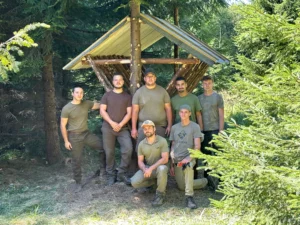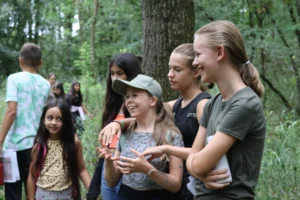First of all, I would like to begin my report by thanking you. I would like to thank the Fauna and Flora Foundation for providing us with accommodation, meals, travel and the opportunity to participate in the scientific conference, thus contributing to our professional development. We gained a lot of knowledge, experience and good human relations during the five days we spent together.
For us, the event started on "Day 0" before the conference started. At our accommodation in Mohács, we met Dorka from the Fauna and Flora Foundation, who, as in all the previous contacts and exchanges of information, welcomed us with kindness and willingness. Just a few minutes before me, Balázs, a student at MATE, ran in, the other colleague attending the conference. After quick introductions and introductions, the grant contracts were signed and we agreed on the exact schedule for the rest of the day. The programme of events looked promising, so after a short evening stroll around the main square of Mohács we settled down in our rooms.
The first day started without a hitch. We left for the conference with Dorka and Balazs at the appointed time. After a few minutes of waiting we crossed the border. No more waiting time than that was experienced on the way there and back in the following days. Crossing into Croatia, I had a strange feeling as I thought about the fact that the land and landscape I was seeing for the first time had once belonged to our country. All that said, I did not feel at all like we were abroad. As always, our journey was smooth. We arrived in time in Osijek - the main venue of the conference - the Faculty of Agricultural Biotechnology Sciences of the University of Osijek. Here we met two members of the Board of Trustees of the Fauna and Flora Foundation. Together with them we registered at the entrance of the event. After entering, the elements of the poster session were set up in front of the conference room. It was instructive to look through the line-up, as we were able to see many examples of several levels of quality. Of these, the poster by Erika Csányi clearly stood out for its content and visual form.
The event opened at 9:00 am, followed by the scientific technical presentations. The first session was on deer antlers and conservation. We heard about the role of deer antlers as an indicator, the comparison of the biomechanical characteristics of antlers of different cervids, and the debates on the taxonomy of cervids and their antler homology. After each presentation, the audience was given the opportunity to ask questions, which was often taken up by several people. Coffee breaks were held between the lectures from 10:30 to 11:00 each day. During these breaks, we were able to meet experts from all over the world and ask them in person about their research areas, their results or the possibility of establishing collaborations. After coffee and then lunch at noon, the presentations continued on time. During the rest of the day, speakers came from the United States, Mexico, Lithuania, the Czech Republic, the Middle East and the Far East. The cervids studied included deer, fallow deer, Mesopotamian fallow deer, elk, roe deer, David's deer, hangul, white-tailed deer, mule deer and black-tailed deer. At the end of the presentations, we went to listen to the deer bellowing, which for many of us was one of the unforgettable experiences of the conference. It was an extremely intense roar that evening. We counted 9 to 10 bulls in one place. As darkness fell, we headed home. On the way, we pulled over twice more to continue listening to the magical sounds of the bulls bellowing. But the beautiful moments were interrupted by a noisy approaching vehicle and then a flashing blue sign. Croatian police officers were in a komapkt SUV side-by-side vehicle. They gave us a stern warning and then apparently couldn't put our story together. They couldn't understand what three scientific conference participants from Hungary were doing on a man-made road running through the middle of the hunting area during an intense hunt with deer roaring. In any case, they found our papers in order and politely but emphatically asked us not to stop again, for our own sake, to avoid dangerous situations, as there was hunting going on in the area. It is true that this put an end to the deer shoot for us, but in my opinion the police officers who took action were exemplary. Later, on the way, I wondered whether similarly equipped police officers could be useful in our country in the interests of game farmers. Arriving at our accommodation, we retired after a long day. We prepared ourselves for the rest of the week.
The second day started and ran in the same order as the first. The presentations were grouped around deer habitat, conservation and management. The presentations touched on current issues such as habitat change due to climate change and the associated herd migration, as well as the characteristics of populations in altered habitats. Of this series, the presentations from New Zealand were the most interesting to me, describing research on moose farms. They gave staggering figures coupled with incredible pictures. We also learned that the genetic basis of the best antlered deer herd there comes from Hungarian deer. On this day the presentations went on until 19:30. It was worth watching all of them, because apart from the interesting research topics, we could learn a lot about presentation methods and what makes a good or even bad presentation. I feel that this is useful professional knowledge for us as young and inexperienced lecturers, which we will be able to make use of in the future.
On the third day we went on a study tour. We visited the Kopacs National Park, also known by some as the Amazon of Europe. A diverse floodplain area with all its typical features and an extremely rich birdlife. It was interesting and also nice to hear the National Park staff speaking Hungarian to each other. During our boat trip on the river, I took a number of photos, which will be available to view alongside my report. The next stop on our journey was a winery with a centuries-old history. Here, we were able to taste three batches of the winery's wines while touring the beautifully preserved and actively used historic cellar system on three floors. In the half hour free at the end of the tour, we could feel the creative power of the wine cellar. In this short time, we made more useful contacts with my colleague Balázs than during all the "Coffee breaks" combined. We ended our visit among the vineyards of the wine region. From here we made our way back to Osijek, where we returned to our accommodation in Mohács after a lunch of local specialities. After a quick refreshment and dressing, we headed back to Croatia for the gala dinner. The welcome was very warm. We were introduced to the courses of the dinner. It was pointed out that many of the elements were from Hungarian cuisine, which goes back to its historical past. They spoke with great respect about their Hungarian neighbours. Their dishes were truly reminiscent of the flavours of home. The main attraction, and therefore the most popular dish, was the death juice cooked in four pots over a blazing fire. After tasting it, the Mexican colleague sitting opposite me tipped his authentic hat. The dinner was a very good time. There was plenty on offer. A Croatian folk band arrived, which further enhanced the evening. In addition to the many culinary and cultural stimuli and sources of experience, we also managed to make new professional contacts and acquire new knowledge. At the end of the dinner we returned to Mohács with Balázs, enriched with new experiences, a little tired but in a good mood.
The fourth day featured presentations on wildlife health. Several studies on deer and roe deer diseases were of interest to me. After the session presentations, the optional trip followed in the afternoon. On this trip we visited less technical and more cultural attractions. We visited Dakovo, where Lipica cattle were bred and selected, and then we got to see the history of the local church. During the bus trip, our guide provided us with a wealth of local history and cultural information. On this occasion, too, the Hungarian past and ties were evident in all areas. Our journey ended at 9:30 in the evening, bringing the conference to a close for us.
On Friday morning, we set off with Balázs, a good man and a new professional friend, well rested and with a lot of new experiences, knowledge and experiences. I hope that in writing my report, in the 8959 characters I have typed so far, I have been able to convey, even if only a little, the professional and cultural experience I have had during these four days. Once again, I would like to thank the Fauna and Flora Foundation for making this possible and for contributing to this life-changing experience.





